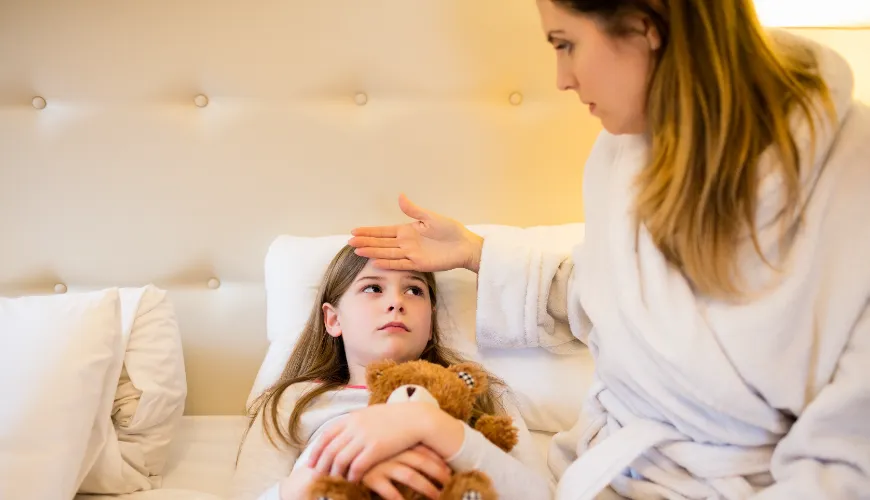
High Fever in Children Without Other Symptoms and When to See a Doctor

High Fever in Children Without Other Symptoms
When a child develops a high fever without other symptoms, it's natural for parents to become uneasy. Fever is a common accompaniment to many infections, but what if there are no other signs of illness? There's no cough, runny nose, or rash. How can one tell when it's a normal body reaction and when it's time to consult a doctor?
The first question most parents ask is: where did the fever come from? A child's body may sometimes respond to an infection with a fever before other symptoms appear. Occasionally, symptoms develop only after a day or two. But there are situations where fever remains the sole sign of illness – and it's crucial to know how to proceed in those cases.
What Does High Fever in Children Actually Mean?
A fever is considered a body temperature above 38 °C, with high fever potentially reaching up to 40 °C. In children, fever is more frequent and intense than in adults because their immune system is still developing and learning to fight pathogens. Fever is thus a natural defense mechanism of the body.
However, there is a difference between a slightly elevated temperature after vaccination and a fever that rises to 40 °C without an apparent cause. Especially if it lasts longer than 24–48 hours and is not accompanied by any other symptoms, caution is advised.
Common Causes of Fever Without Other Symptoms
A fever that initially seems completely mysterious often has a quite reasonable explanation – even if it doesn't appear that way at first. One of the most common reasons is a beginning viral infection, such as classic flu or various enteroviruses. The body responds with a sharp fever on the first day, and only then come the familiar troubles like a runny nose, sore throat, or cough.
Another frequent culprit is a urinary tract infection, which often occurs "undercover" in young children – aside from high temperature, the child may not show any other problems. A specific example is the so-called sixth disease, also known as roseola: the child suddenly spikes a fever for three days without other symptoms, and when the fever disappears, a mild rash appears, as if the body wanted to remind one last time.
Sometimes, more serious conditions like bacterial infections – such as pneumonia, meningitis, or hidden inflammation somewhere in the body – are the cause, and it's crucial to act quickly and consult a doctor in time. Lastly, let's not forget that young children can also easily overheat – especially in the summer sun or when dressed for Siberia, even if they could comfortably be running around in a T-shirt.
In some cases, however, the exact cause remains undetermined. A study published in Pediatrics states that in up to 30% of fever cases in young children without other symptoms, the diagnosis remains unclear, yet most of these conditions resolve without complications.
When to See a Doctor with Your Child?
Although most fevers in children have a benign course, there are situations where immediate medical attention is necessary. These include:
- Child younger than 3 months – any fever in a newborn requires medical examination.
- Fever above 39 °C lasting more than 48 hours without other symptoms.
- Lethargy, confusion, breathing difficulties, or other signs of serious illness.
- Significant pain – for example, during urination (possible urinary tract infection).
- Seizures – febrile seizures are common, but always require a doctor's consultation.
It is important to monitor not only the temperature but also the child's overall condition. If the child is playing, drinking, and responding normally, the situation may not be dramatic despite the fever. Conversely, lethargy, refusal to drink, and significant behavior changes are warning signs.
How to Properly Handle Fever in Children?
First and foremost, ensure adequate fluid intake. Dehydration is a common and dangerous risk during fever. Ideal options include light teas, water, or electrolyte drinks designed for children. It is also advisable to keep the child in a restful state, with loose and light clothing.
Fever-reducing medications, such as paracetamol or ibuprofen, can be used, but always according to the recommended dosage and considering the child's age. The goal is not to reduce the temperature to normal levels at any cost, but to alleviate discomfort and prevent an excessive rise.
Cooling compresses or lukewarm baths can be helpful, but they should be used cautiously. The child should never be exposed to water that is too cold, as this could trigger a shock reaction.
How High Fever Without Symptoms Developed into Sixth Disease
The mother of three-year-old Matyáš shared: "When Matýsek developed a fever of 39.5 °C and was otherwise completely fine, I was desperate. The fever continued the next day, but there was no cough, runny nose, or rash. Finally, on the third day, the fever suddenly subsided, and small red spots appeared on his back. The doctor confirmed it was the sixth disease and explained that it is common in young children." This story illustrates that even high fever without symptoms can have a harmless cause, but it's always good to keep the situation under control.
Prevention and Boosting Immunity
Although not all fevers can be prevented, boosting children's immunity can reduce the frequency of infections. Important factors include sufficient sleep, a varied diet rich in vitamins (especially vitamin C and D), regular outdoor exercise, and proper hygiene, such as thorough handwashing.
The environment in which the child grows up also plays a significant role. Minimizing stress and positive mental well-being have a key impact on the body's resistance to infections, according to research from Harvard Medical School.
When Fever Helps
Although fever is often perceived as an enemy, it is actually part of the body's defense strategy. Higher body temperature slows down the multiplication of bacteria and viruses and activates the immune system. As the renowned American pediatrician Dr. Barton D. Schmitt said: "Fever is a friend, not an enemy." Treatment approaches should thus be thoughtful – the goal is not to immediately suppress the fever, but to help the child manage the illness as gently as possible.
High fever in children without other symptoms is a situation that deserves attention, but it is not always a cause for panic. With a bit of calm, proper care, and timely consultation with a pediatrician, most cases can be safely managed without complications.

